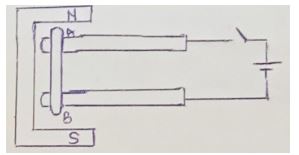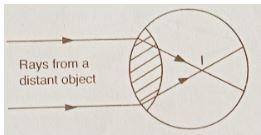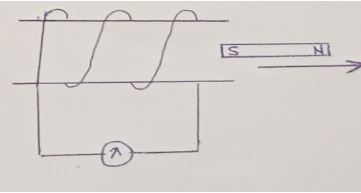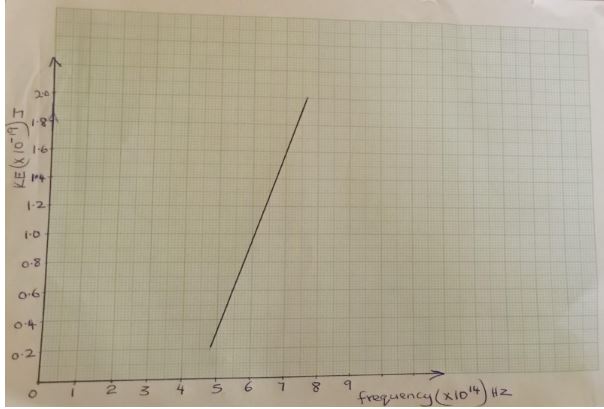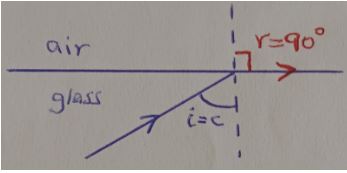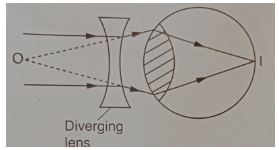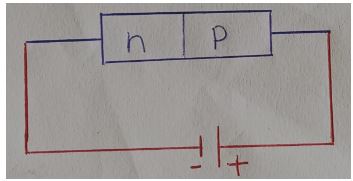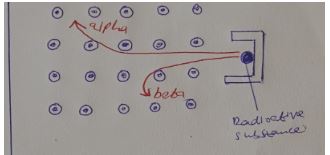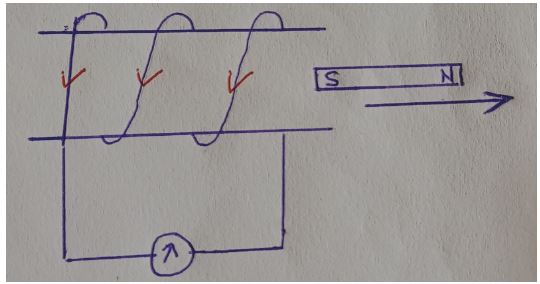INSTRUCTIONS TO CANDIDATES
- Attempt ALL questions in sections A and B.
- All your answers must be written in the spaces provided in this question paper.
- All working must be clearly shown
- Non programmable silent electronic calculators and KNEC mathematical tables may be used.
SECTION A: (25 MARKS)
- A student rubs an iron rod with a duster. State with reason whether the rod became charged or not. (2mk)
- A pinhole camera of length 10cm forms an image of a magnification 0.85.Calculate the distance between the object and pinhole of the camera. (3mk)
- Briefly describe how you can demagnetise a bar magnet using electrical method. (3mk)
- You are provided with three cells each of 1.5V emf. What is the effective emf when the three cells are connected in parallel? (1mk)
- A candle is placed in front of a spherical mirror. A sharp image is formed on the screen. State with reason the type of spherical mirror used. (2mk)
- A copper rod AB is placed on two other rods in horizontal positions and within the magnetic field. The rod is placed such that the field of the permanent magnet is parallel to the length of rod AB as shows below.
State with reason whether the rod rolls when the switch is closed or not? (2mk) - The figure below shows a displacement time graph of a given wave.
Determine the frequency of this wave. (2mk) - The figure below shows a light ray from glass towards air.
(i = angle of incidence and c = the critical angle)
Complete the diagram to show direction taken by the ray hence determine the angle of refraction showing it on the diagram. (2mks) - When air is blown over the mouth of a test tube, sound is heard. What causes the soundproduced? (1mk)
- Two resistors 8 Ω and 5 Ω are connected in parallel to each other and across a battery of emf 6V. If the battery has internal resistance of 1.25 Ω, calculate the total current circulating in the circuit. (3mk)
- A plane water wave moves from a deep region to a shallow region as shown.
Name two quantities of the wave which are affected when it crosses the boundary and for each one of them state how it is affected. (2mk) - When a hollow conductor is charged in its inner surface and then the conductor is tested for presence of charge at the inner side, state the expected observation. (1mk)
- Arrange the following in order of increasing wavelength. Microwave, x ray, visible light, UV. (1mk)
SECTION B (55 MARKS)
-
- The figure below shows an image formed by a biconcave lens.
F is the principal focus.- Complete the ray diagram to locate the object. (2mk)
- From your diagram calculate the magnification. (1mk)
- The figure below shows an eye with a defect.
- Name the defect. (1mk)
- Explain this defect in relation to how the person view objects at different distances. (2mk)
- In the space provided below redraw the diagram above and complete it to show how a lens is used to correct the defect. (3mk)
- The figure below shows an image formed by a biconcave lens.
-
-
- Explain how the n-type semiconductor is made (1mk)
- The figure below shows p-n junction diode
Complete the diagram to show how you can connect the diode in forward bias (1mk)
- X-rays are electromagnetic waves produced in x-ray tubes.
- Briefly describe how x-rays are produced. (1mk)
- Name the material used to make the metal target in an X ray tube. (1mk)
- State the reason why the material named in (¡¡) above is preferred over other materials. (1mk)
- How can intensity of x-rays produced in an x-ray tube be increased? (1mk)
- An x-ray tube has an accelerating voltage of 80KV. (Given that the planks constant h = 6.63 × 10 −34 Js, electron charge (e) = 1.6 × 10 −19 C, mass of electron (m e ) = 9.1 × 10 −31 kg)
Determine;- maximum frequency of x-rays produced. (2mks)
- Velocity of electrons in the x-ray tube. (3mks)
-
-
- A radioactive source produces the beta and alpha particles which then moves through magnetic field (see the figure below).
Complete the diagram to indicate the path taken by the two radiations. (Label your diagram). (2mk) - Uranium disintegrates as shown below
- identify radiations A and B
A (1mk)
B (1mk)
- identify radiations A and B
- A d.c voltage of 75V is applied to the Y plates of a CRO set at Y-gain sensitivity of 20V/cm
- Determine how far the spot would be deflected verticaly (in cm) from the center line. (2mk)
- If the d.c voltage is replaced with an a.c voltage of 75V and of high frequency sketch a diagram to show what would be observed on the screen. (indicate the centre line of your CRO screen). (2mk)
- If in (¡¡) above the time base is switched on and set at 10ms/cm and that the frequency of a.c. is 50Hz. Determine
- The period of the trace on the screen (1mk)
- The wavelength in cm as seen on the screen. (2mk)
- A radioactive source produces the beta and alpha particles which then moves through magnetic field (see the figure below).
-
-
- State the reason why electrical power is transmitted at high voltage. (1mk)
- In domestic wiring the neutral wire reaches the house at zero potential. What is done to the neutral wire to make it be zero potential. (1mk)
-
- State the Faraday's law of electromagnetic induction. (1mk)
- A bar magnet initially inside a coil is pulled out at high speed as shown below.
Indicate on the diagram the direction of current in the coil hence name the law used to determine this direction. (1mk) - One of the energy loses in a transformer is Flux leakage. State what is meant by the term Flux leakage. (1mk)
- A generator produces 450KW at 11KV. This power is then fed to a step up transformer of efficiency 92%. The turns ratio of primary coil to secondary coil is 1:12.
Determine;- The output voltage of the transformer. (3mk)
- The power output of the transformer. (2mk)
- The secondary current of the transformer. (2mk)
-
-
- Define the term work function as used in photoelectric effect. (1mk)
- A photocell is illuminated with a given radiation. State two factors that would determine whether the electrons will be dislodged from its cathode or not. (2mk)
- The figure below shows a graph of maximum kinetic energy (KE max ) of photo electrons emmited in a photocell against frequency (f) of incident radiations.
Given that the speed of light (c) is 3.0×10 8 m/s, determine from your graph;- plank's constant (h) (3mk)
- Threshold frequency (fo ) (2mk)
- Calculate threshold wavelength (2mk)
- Calculate work function in Joules
MARKING SCHEME
- Does not become charged because the charge is leaked away.
- mag = V/U
0.85 = 10 cm/U
U = 11.76 cm -
- place the bar magnet inside a solenoid.
- place the solenoid and magnet in the East- West direction.
- connect the solenoid to a.c. source and switch on.
- 1.5 V
- Concave, because a real image is formed.
- Does not roll because no force is produced when the rod is parallel to the magnetic field.
- frequency (f) = 1/T
f = 1/0.5
f = 2 Hz
- Vibration of air column.
- E = I(R + r)
6 = I( R + 1.25)
But, R = ( 8 x 5 )/ (8 +5 )
R = 3.077 Ω
6 = l (3.077 + 1.25 )
I = 1.387 A - Velocity decreases, wavelength decreases.
-
- No net charge on the inner surface of the conductor. The charge resides on the outer surface.
- Higher resistor, reduced the current flowing in the circuit.
- X- rays ---- ultraviolet ---- visible light ----- microwave.
SECTION B
-
-
- mag = v/u
= 1.1/1.4
= 0.785
-
- short-sightedness or myopia
- Near objects are seen clearly while far objects appear blurred.
-
- focal length
-
-
-
- made by doping an intrinsic semi conductor with pentavalent atom.
-
-
- when fast moving electrons are suddenly stopped on hitting a metal target .
- tungsten (or molybdenum)
- because of its high melting point.
- increasing the heater current.
- decreasing the accelerating potential difference or voltage.
-
- eV = hf
f = eV/h
f = (1.6 x 10−19) x( 80000)/(6.63 x 10−34)
f = 1.93 x 10−19 Hz - eV = ½ mv2
v2 = (2.6KI.6 x10−19 )/(9.1 x10−31)
v = √2.813
v = 1.68 x 108 m/s
- eV = hf
-
-
-
-
-
- A----alpha particles
- B ---- beta particles
-
-
- deflection = voltage applied/sensitivity.
deflection = 75v/(20v/cm)
= 3.75 cm -
A straight vertical line 1mk Centre line 1mk
- period = 1/f
= 1/50
= 0.02 seconds
sensitivity of 10ms/cm= 0.01s/cm
therefore , cm covered in one oscillation = 0.02s/(0.01s/cm)
= 2 cm
- deflection = voltage applied/sensitivity.
-
-
-
- At high voltage, current is low hence reducing power losses due to heating effect of current.
- neutral wire is earthed at the transformer.
- power or ring main circuit.
-
- The magnitude of the induced emf is directly proportional to the rate of change of magnetic flux linkage.
- use lenz's law.
- it means some of the magnetic flux produced by primary coil fails to link with secondary coil.
-
- Vs/Vp = Ns/Np
Ns;Np = 12:1
Vs/11000 = 12/1
Vs = 12/1 x 11000
Vs = 132000 v - % Efficiency = power output/power input x 100%
92% = 450kw/power input x 100%
Power input = 489.13 KW = 489130 W - power output = Vs x Is
489130 = 132000 x Is
Is = 3.71 A
- Vs/Vp = Ns/Np
-
-
-
- The minimum amount of energy needed to dislodge an electron from a metal surface.
-
- energy of the radiation.
- work function of the Cathode.
-
- h = gradient
h = { (1.59 − 0.3) x 10−19}
{(7 − 5) x 1014}
h = 6.45 x 10−34 Js
P(ii) at ke = 0 - f = fo
f = 4.5 x 1014 Hz - c = fo x threshold wavelength
3.0 x 108 m/s = 4.5 x1014 x threshold wavelength
Threshold wavelength = 6.67 x 10−7m - Wo = hfo
Wo = 6.45 x 10−34 x 4.5 x 1014
Wo = 2.9 x10−19 J
- h = gradient
-
Download Physics Paper 2 Questions and Answers - Lainaku II Joint Mock Examination 2023.
Tap Here to Download for 50/-
Get on WhatsApp for 50/-
Why download?
- ✔ To read offline at any time.
- ✔ To Print at your convenience
- ✔ Share Easily with Friends / Students

